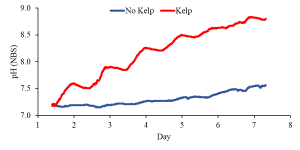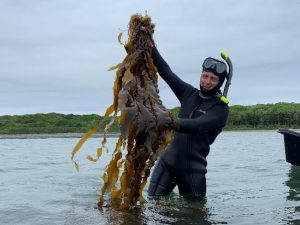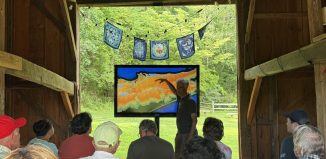SBU’s Christoper Gobler, Mike Doall show how kelp helps oysters
By Daniel Dunaief
Kelp, and other seaweed, may prove to be an oyster’s best friend. And, no, this isn’t a script for a new episode of SpongeBob SquarePants.
A thick, heavy leafy seaweed, kelp provides an environmentally friendly solution to several problems. Amid higher levels of carbon dioxide, the air has become warmer and oceans, including coastal regions, are more acidic. That’s because carbon dioxide mixes with water, producing negative hydrogen ions that lower the pH of the water.
Enter kelp.
A rapidly growing seaweed, kelp, which is endemic to the area, uses that carbon dioxide in the same way trees do, as a part of photosynthesis. By removing carbon dioxide, kelp raises the pH, which is helpful for the area’s shellfish.

That’s the conclusion of a recent study published in Frontiers in Marine Science by Stony Brook University Professor Christopher Gobler, Endowed Chair of Coastal Ecology and Conservation at the School of Marine and Atmospheric Sciences, and Mike Doall, Associate Director of Shellfish Restoration and Aquaculture at Stony Brook University.
In a series of five laboratory experiments and a field study, Gobler and Doall showed that kelp lowered acidification, enabling better growth for shellfish like oysters. “There was better oyster growth inside the kelp than 50 meters away” Doall said, in what he and Gobler describe as the “halo” effect.
Gobler was especially pleased with the implications of the field experiment.“While showing that [result] in the lab was exciting, being able to improve the growth of oysters on an oyster farm experiencing coastal acidification proves this approach can have very broad implications,” Gobler said in a statement.
Doall estimates that kelp farmers can grow 72,000 pounds per acre of kelp in just six months, during the prime growing season from December through May.
Doall, whose primary role in the study was to grow the kelp and set up the field experiment, said he grew kelp at the Great Gun oyster farm in Moriches Bay that were up to 12 feet long. Over the last four years, he has grown kelp in 16 locations around Long Island, from the East River to Fishers Island.
This year, the team conducted kelp studies in nine locations. The best growth occurred in the East River and in Moriches Bay, Doall said. He harvested about 2,000 pounds each from those two sites this year and is primarily using the kelp in a host of fertilizer studies.
Gobler explained that using seaweed like kelp could enhance aquaculture.
“The intensification of ocean acidification now threatens bivalve aquaculture and has necessitated a solution,” Gobler said in a statement. “We believe our work is foundational to a solution.”

One of the challenges of using kelp to improve the local conditions for shellfish is that it grows during the winter through May, while the growing season for shellfish occurs during the summer.
“That is why we are now working on summer seaweeds,” Gobler explained in an email.
Gobler and Doall are looking for similar potential localized benefits from Ulva, a green sea lettuce, and Gracilaria, which is a red, branchy seaweed.
“Most water quality issues occur during summer, so it’s important to grow seaweed year round,” Doall said.
The Stony Brook scientists, who have worked together since the early 1990s when they were graduate students, are also exploring varieties of kelp that might be more heat tolerant and will try to use some of those on Long Island.
Woods Hole Oceanographic Institution is leading a project to hybridize these heartier strains of kelp, Doall said. GreenWave, which supports regenerative ocean farming, is also participating in that effort.
Gobler explained that they also plan to start earlier, which will extend the growing season.
While the different growing seasons for kelp and oysters may make kelp only part of the solution for reducing ocean acidification for shellfish, the different growing seasons makes the seaweed a complementary companion crop for commercial shellfish diggers.
Summer laborers who work on oysters can transition to kelp harvesting in the fall and winter.
A resident of Rocky Point, Doall lives with his wife Nancy, who teaches at North Coleman Road Elementary School in the Middle Country School District.
The Doall’s 23-year old daughter Deanna, who is a graduate of the University of Tampa, is currently traveling in Guatemala, while their 20-year old daughter Annie is attending Florida Gulf Coast University.
Doall grew up in Massapequa Park. As a 12-year old, he pooled his lawn mowing money with a friend’s paper route funds to buy a small boat with a 1967 10-horsepower Evinrude engine. The pair went out on bays to fish and, periodically, to clam.
Doall, who loves gardening and being in the ocean, described the two of them as being “notorious” for needing tows back to the shore regularly when their engine died.
The former owner of an oyster farm, Doall also enjoys eating them. He particularly enjoys eating oysters in the winter and early spring, when they are plump. His favorite way to eat them is raw on the half shell, but he also appreciates his wife’s “killer Oysters Rockefeller,” as he described it.
As for kelp, the current supply in the area exceeds the demand. The excess kelp, which farmers harvest to prevent the release of carbon dioxide and nitrogen that the seaweed removed from the water, can be composted or used for fertilizer, explained Gobler.






